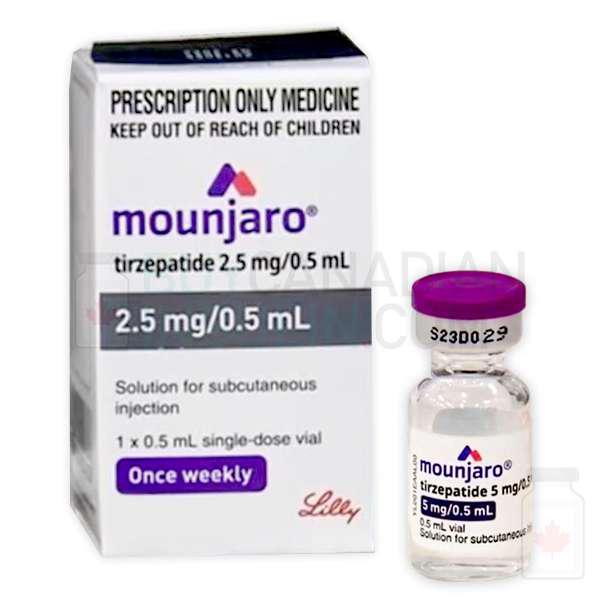Mounjaro weight loss injection
$375.00 – $500.00
Mounjaro is the brand name for tirzepatide, a once‑weekly injectable medication developed by Eli Lilly. Approved by the FDA in May 2022 for type 2 diabetes, it acts as a dual GIP and GLP‑1 receptor agonist, offering superior effects over GLP‑1–only drugs like Ozempic or Wegovy . Since November 2023, tirzepatide under the name Zepbound has been approved for weight management .
Description
What Is Mounjaro?
Mounjaro is the brand name for tirzepatide, a once‑weekly injectable medication developed by Eli Lilly. Approved by the FDA in May 2022 for type 2 diabetes, it acts as a dual GIP and GLP‑1 receptor agonist, offering superior effects over GLP‑1–only drugs like Ozempic or Wegovy . Since November 2023, tirzepatide under the name Zepbound has been approved for weight management .
How Does Mounjaro Work?
Mounjaro mimics two hormones:
- GIP (glucose‑dependent insulinotropic polypeptide) to amplify insulin release
- GLP‑1 (glucagon‑like peptide‑1) to improve sugar control and reduce appetite 
This dual-action results in:
- Reduced blood sugar (HbA1c decreases up to 2.4%)
- Significant weight loss (15%–22.5% on average in SURPASS/SURMOUNT trials)  
Studies suggest Mounjaro delivers faster and greater weight loss than Ozempic: about 10.1% weight loss at 6 months vs. 5.9%, and 15.2% at one year vs. 7.9% .
Benefits of Using Mounjaro
- Dual mechanism yields superior glucose control and weight reduction
- Once-weekly dosing, convenient and easy to follow
- Improved metabolic health, including potential heart and liver benefits   
- Motivation-enhancing results when combined with diet and exercise 
Side Effects & Safety Profile
Common side effects include:
- Nausea, vomiting, diarrhea, constipation
- Decreased appetite, mild abdominal discomfort
These often ease over several weeks  .
Serious warnings:
- Boxed warning for thyroid C-cell tumors; contraindicated in patients with a family or personal history of medullary thyroid carcinoma or MEN 2 syndrome .
- Rare risks: pancreatitis, gallbladder issues, kidney changes or hypoglycemia when used with insulin .
Who Should Consider Mounjaro?
- Adults with type 2 diabetes needing better glycemic control
- Individuals with obesity or overweight and a weight-related health condition (e.g., high blood pressure, sleep apnea, prediabetes) 
- People struggling to lose weight through lifestyle alone
It’s not recommended for type 1 diabetes, pregnancy, or those with thyroid cancer histories .
How to Use Mounjaro
- Administered via once-weekly subcutaneous injection, using a pre‑filled pen (abdomen, thigh, upper arm)
- Common dosage progression: start at 2.5 mg, gradually increase to 5, 7.5, 10, up to 15 mg depending on tolerance and goals 
Getting Started & Cost Considerations
- Requires a prescription from a healthcare provider
- Insurance often covers it for diabetes; weight-loss use may need prior authorization
- Manufacturer coupons and patient assistance programs can help offset costs, though long-term use may still exceed $1,000/month without coverage .
Does Mounjaro cause weight loss without diabetes?
Yes—clinical trial results show non-diabetic individuals lost 15–22.5% of body weight at higher doses over ~72 weeks .
How does Mounjaro compare to Ozempic or Wegovy?
Its dual-hormone mechanism gives Mounjaro an edge: greater HbA1c reductions and superior weight loss outcomes whereas Ozempic/Wegovy are GLP‑1 only .
How fast will I see results?
Initial appetite reduction can occur in days. Typical weight loss: ~5.9% at 3 months, ~10.1% at 6 months, ~15% at one year, depending on dose and adherence .
What are the top concerns using Mounjaro?
Thyroid cancer risk (boxed warning) and gastrointestinal discomfort are key concerns. Close medical supervision is required .
Target
Primary Keywords:
- Mounjaro
- Mounjaro tirzepatide
- Mounjaro weight loss
- Mounjaro side effects
- How does Mounjaro work
- Mounjaro vs Ozempic
Secondary Keywords / Long-tail Keywords:
- Mounjaro for type 2 diabetes
- Mounjaro dosage 15 mg
- Mounjaro before and after results
- Mounjaro cost insurance coverage
- Mounjaro injection weekly pen
- Mounjaro dual GIP GLP‑1 agonizing
Additional information
| Quantity | 2.5mg, 7.5mg |
|---|





Reviews
There are no reviews yet.